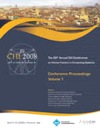CHI 2008: a selection on strategic issues
(Papers are linked to their pdf downloads, if available.)
Empathy and experience in HCI [abstract]
Authors: Peter Wright (Sheffield Hallam University) and John McCarthy (University College Cork)
Abstract: For a decade HCI researchers and practitioners have been developing methods, practices and designs ‘for the full range of human experience’. On the one hand, a variety of approaches to design, such as aesthetic, affective, and ludic that emphasize particular qualities and contexts of experience and particular approaches to intervening in interactive experience have become focal. On the other, a variety of approaches to understanding users and user experience, based on narrative, biography, and role-play have been developed and deployed. These developments can be viewed in terms of one of the seminal commitments of HCI, ‘to know the user’. Empathy has been used as a defining characteristic of designer-user relationships when design is concerned with user experience. In this article, we use ’empathy’ to help position some emerging design and user-experience methodologies in terms of dynamically shifting relationships between designers, users, and artefacts.
Interactional empowerment [abstract]
Authors: Kristina Höök (Mobile Life center at Stockholm University), Anna Ståhl (Swedish Institute of Computer Science), Petra Sundström (Mobile Life center at Stockholm University) and Jarmo Laaksolaahti (Swedish Institute of Computer Science)
Abstract: We propose that an interactional perspective on how emotion is constructed, shared and experienced, may be a good basis for designing affective interactional systems that do not infringe on privacy or autonomy, but instead empowers users. An interactional design perspective may make use of design elements such as open-ended, ambiguous, yet familiar, interaction surfaces that users can use as a basis to make sense of their own emotions and their communication with one-another. We describe the interactional view on design for emotional communication, and provide a set of orienting design concepts and methods for design and evaluation that help translate the interactional view into viable applications. From an embodied interaction theory perspective, we argue for a non-dualistic, non-reductionist view on affective interaction design.
Healthy technology: a metaphor that pushed user experience to new strategic heights at Intel [abstract]
Authors: Ashwini Asokan and Michael J. Payne (Intel Corporation, Digital Home Group, User Experience Group)
Abstract: One of the biggest struggles user experience teams face is breaking through traditional notions of product strategy, planning and development to bring actionable awareness to the bigger picture around delivering full experiences that people really care about. User research and design is often focused around product & feature design in a space that is defined by out-dated boundaries imposed by history or pre-existing constraints. Research is used to create new features or product direction within these walls, and many design tools are employed to ensure the experience delivered is acceptable. This paper uses a case study of a project titled “Healthy Technology” to highlight the important role that metaphors can play in shifting conversations & strategy, from executive managers to development teams, leading to new boundaries, new strategies, a fresh look at what it means to set direction that targets complete user experiences rather than consumer appreciated features. The metaphor is discussed, through example, as more than a tool for user interface design, exploring the same as a means to alter strategic thinking in upper management as well as guide design and development teams in rethinking notions of technology to create new categories, rethink the problem space and to think beyond features. This paper outlines the research processes that lead to the creation of a metaphor and the functions of the metaphor in overcoming traditional boundaries and thinking. It describes key challenges and methods in this process of moving from research to strategic initiatives that fundamentally shift thinking, providing direction for business models, services, technologies, and industry alignment that come together to provide more than just features or products.
User experience over time
Authors: Evangelos Karapanos (Eindhoven University of Technology), Marc Hassenzahl (University of Koblenz-Landau) and Jean-Bernard Martens (Eindhoven University of Technology)
Abstract: The way we experience and evaluate interactive products develops over time. An exploratory study aimed at understanding how users form evaluative judgments during the first experiences with a product as well as after four weeks of use. Goodness, an evaluative judgment related to the overall satisfaction with the product, was largely formed on the basis of pragmatic aspects (i.e. utility and usability) during the first experiences; after four weeks of use identification (i.e. what the products expresses about its owner) became a dominant aspect of how good a product is. Surprisingly, beauty judgments were largely affected by stimulation (e.g. novelty) during the first experiences. Over time stimulation lost its power to make the product beautiful in the users’ eyes.
User experience at Google – focus on the user and all else will follow [abstract]
Authors: Irene Au, Richard Boardman, Robin Jeffries, Patrick Larvie, Antonella Pavese, Jens Riegelsberger, Kerry Rodden and Molly Stevens (Google, Inc.)
Abstract: This paper presents an overview of the User Experience (UX) team at Google. We focus on four aspects of working within Google’s product development organization: (1) a bottom-up ‘ideas’ culture, (2) a data-driven engineering approach, (3) a fast, highly iterative web development cycle, and (4) a global product perspective of designing for multiple countries. Each aspect leads to challenges and opportunities for the UX team. We discuss these, and outline some of the methodological approaches we employ to deal with them, along with some examples of our work.





[…] mobile banking, mobilità , product design, sicurezza, applicazioni sociali, contesto sociale, tematiche di strategia, sostenibilità , e usabilità (in […]